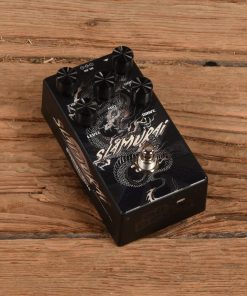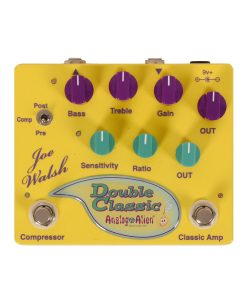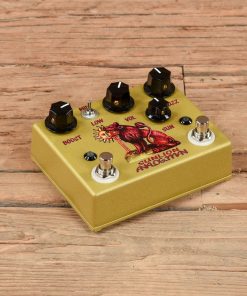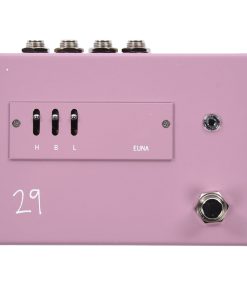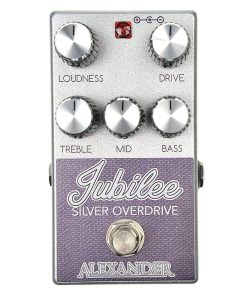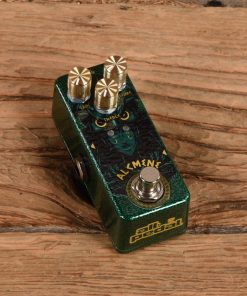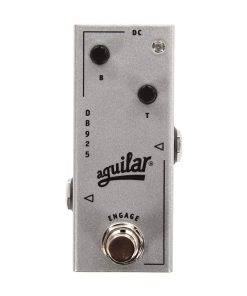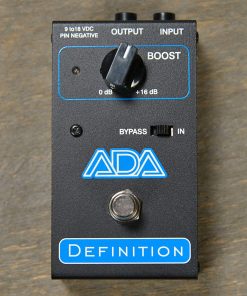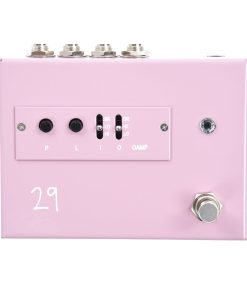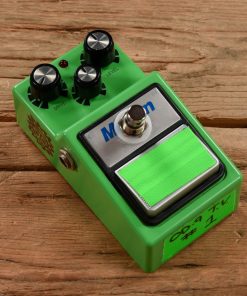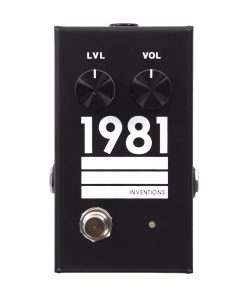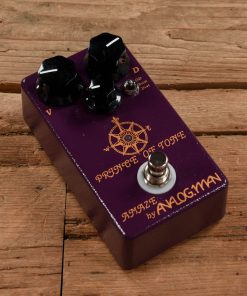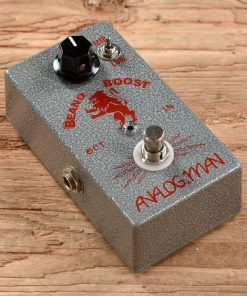Benson Germanium Boost Pedal Benson
$ 199,00 $ 79,60
From Benson:
When designing the temperature controlled fuzz, we tried some weird approaches. One of the things we tried was utilizing a voltage controlled error correcting circuit to bias a single germanium transistor. It ultimately didn’t work for the fuzz, since that circuit is comically sensitive to transistor gain attributes. We did find a place for it though.
It turns out it was PERFECT for achieving a germanium clean boost that, (like our fuzz) is impervious to component drift, leakage, and temperature….moreso in fact. We also fixed a couple other issues preventing the germanium transistor from being used as a convincing linear boost…we increased the input headroom (even a normal guitar signal will drive a germanium transistor into unwanted input distortion without some tweaks) and increased the input impedance (a BJT transistor would normally thin out bass frequencies and interact neg- atively with whatever flows into it).
The result is a germanium clean boost where you can utilize a germanium transistor WITH- OUT the weird artifacts that were previously accepted as part of the deal…temperature sen- sitivity, drift, and suboptimal input impedance and headroom.
It takes about 10 seconds when the boost is first powered up for the error correction circuit to bias the germanium transistor. After that it gets interesting….we can hear how it makes guitar signals sound more musical…even when set at the same volume as the bypassed tone. It seems to bring out the attack of the guitar while simultaneously smoothing out notes, like a compressor but different. It’s hard to describe. It appears to cut the bad parts of a signal and enhance the good. It’s killer on bass. It helps acoustic guitar pickups sound more natu- ral. And of course it’ll push your amp into a frenzy.
Fast Shipping with Professional Packaging
We offer a wide range of shipping options due to our long-standing partnerships with UPS, FedEx and DHL. Our warehouse staff are trained to pack your goods exactly according to the specifications we offer. Before shipping the goods are thoroughly examined and secured. Every day, we send thousands of packages to clients from all over the world. Our determination to be the biggest online retailer in the world is shown by this. The warehouses are located in Europe as much as they are in USA.
Note: Orders with more than one product will be assigned a distinct processing time, dependent on the particular item.
Before shipping, we will examine the items ordered thoroughly before sending the items. The majority of orders are shipped within 48 hrs. The delivery estimate is between 3-7 days.
Returns
The stock is constantly changing and cannot be fully controlled by us because of the involvement of several parties including the factory and our warehouse. Stock levels can fluctuate at any given time. Please be aware that it is possible that your order could become unavailable even after you've placed your order.
Our policy is valid for a period of 30 days. If 30 days have passed by since your purchase however, we're unable to give an exchange or refund.
In order to be eligible for a refund your product must be unopened and in the same state as you received it. It should also be in the original package.
Related products
Effects and Pedals / Overdrive and Boost
Effects and Pedals / Overdrive and Boost
Effects and Pedals / Overdrive and Boost
Effects and Pedals / Overdrive and Boost
Analog Alien Joe Walsh Double Classic Overdrive Pedal Analog Alien
Effects and Pedals / Overdrive and Boost
Effects and Pedals / Overdrive and Boost
Effects and Pedals / Overdrive and Boost
Effects and Pedals / Overdrive and Boost
Effects and Pedals / Overdrive and Boost
Effects and Pedals / Overdrive and Boost
Effects and Pedals / Overdrive and Boost
29 Pedals Special Run Crunch Berry EUNA Elite Unity Amplifier Input Driver 29 Pedals
Effects and Pedals / Overdrive and Boost
Abominable Electronics Oppressive Cult Destroyer Abominable Electronics
Effects and Pedals / Overdrive and Boost
Effects and Pedals / Overdrive and Boost
Effects and Pedals / Overdrive and Boost
Effects and Pedals / Overdrive and Boost
Effects and Pedals / Overdrive and Boost
Effects and Pedals / Overdrive and Boost
Effects and Pedals / Overdrive and Boost
Analogman King of Tone V4 with Red Side High Gain Option Analogman
Effects and Pedals / Overdrive and Boost
Effects and Pedals / Overdrive and Boost
Analog Alien Rumble Seat Overdrive/Delay/Reverb Pedal Analog Alien
Effects and Pedals / Overdrive and Boost
Effects and Pedals / Overdrive and Boost
Effects and Pedals / Overdrive and Boost
Effects and Pedals / Overdrive and Boost
Effects and Pedals / Overdrive and Boost
Effects and Pedals / Overdrive and Boost
Effects and Pedals / Overdrive and Boost
Effects and Pedals / Overdrive and Boost
Effects and Pedals / Overdrive and Boost
Effects and Pedals / Overdrive and Boost
1981 Inventions DRV Overdrive Black Hyperfade 1981 Inventions
Effects and Pedals / Overdrive and Boost





